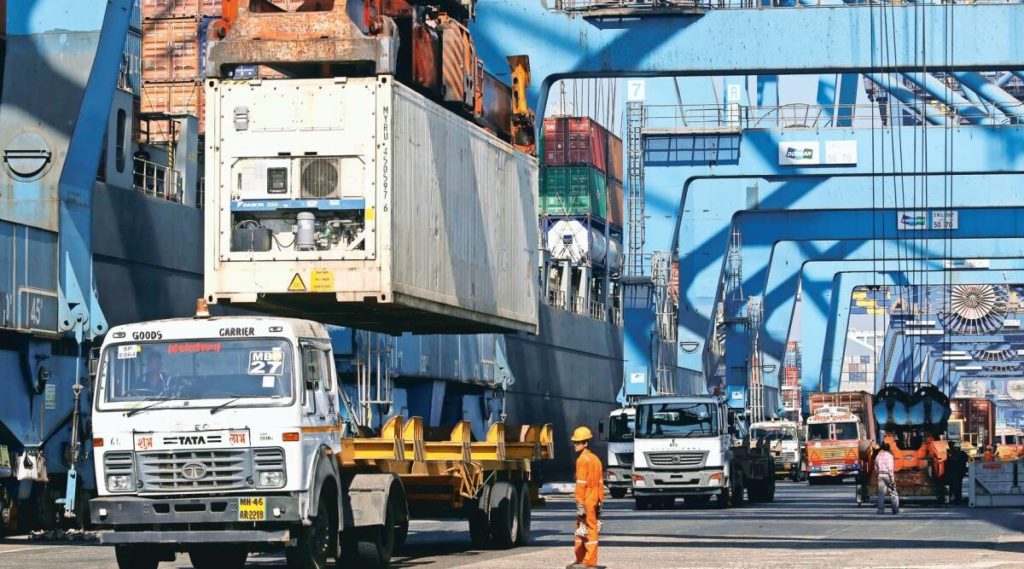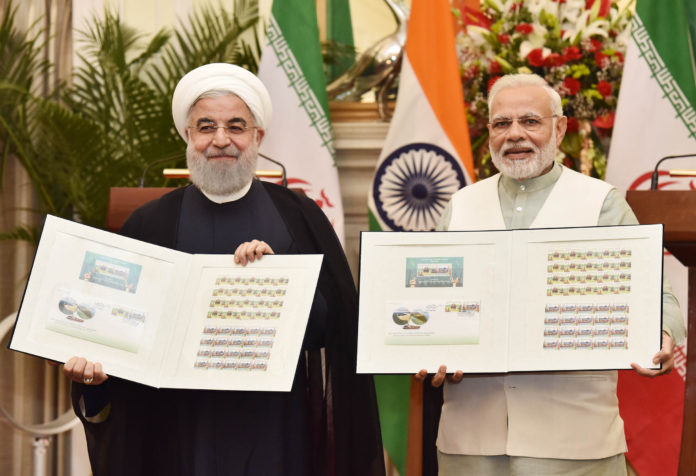Context
President Trump’s decision to withdraw from the 2015 Iran nuclear deal in May this year has ironically put its strategic ally India in a testing position. The energy related sanctions are planned to go into effect on November 4, but other sanctions known as “snap-back” sanctions got implemented on August 7. Snap-back sanctions will target Iranian ability to trade in dollars and its metal, coal, industrial software and auto industry.
India has had a free ride up to this point for its alliance with the US. In the new formulation, US-Indian strategic ties will be acutely tested, and like other allies, it will be pushed to select sides.
Similar to other nations competing in the changing global balance of power dynamics, India has had its feet in different boats. The nation is part of the emerging economic block of BRICS maintaining excellent trade relations with the European Union. Along with Pakistan, India also recently joined the China and Russia led Shanghai Cooperation Organization (SCO), to which Iran is an aspirant too.
At the same time, along with Australia and Japan, India is an integral part of the US Quad strategy for the Pacific meant to counter the Chinese rise. Meanwhile, India has been positioning itself in the Islamic world as a potential candidate for the reformed UN Security Council. It’s doing this by establishing closer ties with other key Muslim nations, such as Saudi Arabia and UAE in the Middle East, and Indonesia and Malaysia in the Pacific.
Like China, Russia, and other European nations, India has close economic ties with Iran, which is the second largest supplier of crude oil to India after Iraq and Saudi Arabia. Moreover, India still has significant defense dealings with Russia, another country under sanctions. Will India decide to alienate its otherwise cordial economic relations with Iran and Russia? Conversely, how far will US go to accommodate the Indian behavior? As it stands right now, the US has twice postponed the 2+2 consultations of the defense and foreign ministers of the two nations, and the next one is scheduled in September.
Analysis
Indian Economic Interests at Stake in Iran
As opposed to what is commonly believed, India is heavily involved in the energy sector of Iran. One of its critical investments in Iran is the strategic Chahbahar port towards which it has committed $500 million. According to Indian Foreign Ministry India-Iran trade for the fiscal year 2016-17 stood at $12.89 billion.
India is one of the biggest investors in Iran’s oil and gas sectors and has been competing with France, which before the imposition of previous sanctions was the leading investor. In 2017, a consortium led by French company Total signed a $4.8 billion deal with Iran to develop the world’s largest South Pars gas fields. Total had 50.1 percent stakes in the world largest South Pars gas fields, while the state-owned China’s National Petroleum Corporation holds 30 percent and the remaining 19.9 percent is owned by Iran’s Petropars.
On the other hand, in 2017 a consortium led by India’s Oil and Natural Gas Corp offered $11 billion to develop Faraz-B gas field and the essential infrastructure for its export.
Iran is also central to the North-South Transport Corridor project (INSTC) that got underway in 2000. This multi-modal transportation route connects Indian Ocean and the Persian Gulf to the Caspian Sea through Iran, and extends to northern Europe through St. Petersburg in Russia.
In the face of US sanctions, China has indicated its intent to take over the stakes of the parties that may depart. Thus, for India to cease its dealing with Iran will mean allowing China to fill the vacuum.
India-Russia Defense Ties
A great part of India’s defense needs, up to 70 percent according to Stockholm International Peace Research Institute (SIPRI), are still provisioned by Russia. The weapons include air defense systems, tanks, and fighter jets. India is also in the final stages of acquiring the sophisticated S-400 air defense system from Russian at the cost of about $6 billion. Judging from the statements emanating from senior Indian officials, it is likely to continue to acquire its defense equipment from Russia, another country under US sanctions. These sanctions, also known as Countering American Adversaries through Sanctions Act (CAASTA), were triggered by the Russian interference in US elections in 2016. However, US Defense Secretary has requested Congress to provide India with a national security waiver, as penalizing the nations would adversely impact US-India strategic ties.
Another significant defense project between India and Russia included the joint development and production of the Multi-role Sukhoi/ HAL Fifth Generation Fighter Aircraft (FGFA). Reportedly, India informed Russia in April 2018 that it was pulling out of the project to develop a stealth fighter jet out of technical concerns. India has annulled many other defense equipment related projects due to its insistence on technology transfer and local production of the equipment. Russia has also leased India nuclear powered submarines, and the country has acquired an aircraft carrier from Russia previously.
India and Russian have considerable cooperation in the civil use of nuclear technology. In the aftermath of the NSG waiver received in 2008, India signed a deal with Russia in 2016 that entails construction of 20 nuclear plants in India, and cooperation in building nuclear plants in third countries. One such project is already underway in Bangladesh. India has been allowed to conduct nuclear commerce despite not having signed the NPT.

India and Europe
As US sanctions get implemented, India will likely evaluate its business ties with Iran, Russia, and EU, and compare it against that of the US.
While Russia fulfills India’s defense needs, Iran is a major energy source for its economy. On the other hand, the European Union has been a big market for Indian products and technology know how. However, the weakening of EU and Brexit has changed the dynamics for India. In the evolving scenario, India’s dealings are transforming from multilateral approach to strengthening bilateral ties with European powers of France, Germany, and UK.
According the European Commission Website, EU is India’s number one trading partner, ahead of China and US. On the other hand, India is EU’s 9th trading partner. The value of EU Imports from India have grown from 22.6 billion in 2006 to 39.3 billion in 2016, while EU exports have grown from 24.2 billion in 2006 to 37.8 billion in 2016. India is a popular destination for European companies involved in automotive, chemical, pharmaceutical, and medical technology industry.
India and Europe have also been also been working hard on the Free Trade Agreement, also known as the Bilateral Trade and Investment Agreement (BTIA). The talks started in 2007 but the agreement has stalled due to the changing nature of the global trade politics. As the tariff war heats up between the US and its allies, including India, it is unlikely any agreement will be signed soon.
Conclusion
As the US sanctions get implemented US Secretary of State, Michael Pompeo has indicated that US is likely to give some exemptions to the countries seeking relief from strict oil sanctions. The US Department of Commerce in early August granted India the Strategic Trade Authorization (STA-1) providing it with an automatic waiver for exports of some types of military and dual-use technologies.
This is after the fact that Indian and Turkish officials recently indicated they would abide by only the UN sanctions on Iran. Even China, EU, and Russia are hesitant to curtail trade ties with Iran and are vowing to continue working with it. In a joint statement that came after the August 7th sanctions went in to effect, the foreign ministers of Germany, France, and Britain have asserted they would strive to preserve Iran’s gas and oil exports. On the other hand, Trump warned of severe consequences for entities that did not abide by the US sanctions.
India is trying to placate the risk emanating from its dealing with Iran and Russia by buying more US defense equipment and crude, while China, which is the largest buyer of US crude and gas in Asia, has stopped importing American crude. India is in the process of implementing a multi-tiered air defense network and in addition to S-400 and Surface to Air missile systems (SAMS), it is also going ahead with getting US National Advanced Surface to Air Missile System II (NASAMS-II) at the cost of $1 billion.
If the European nations, including Turkey, India, and Pakistan, start to ignore the US sanctions, the alternative financial system spearheaded by Russia and China under BRICS and the Chinese One Belt One Road (OBOR) plan is likely to gain momentum. However, India is unlikely to take this route after receiving US waivers.
For the newly elected Pakistan government, the first test may come in the form of Iran-Pakistan gas pipeline (IP). The pressure will build on Pakistan from Iran, Saudi Arabia, and the US regarding the fate of the long-stalled energy project. As the recent US-Turkish split indicates, the US is ready to escalate matters using its economic leverage and Pakistan faces similar risks.
The US is likely to decide on granting waivers on a case-by-case basis depending on its strategic imperatives. India and Afghanistan may get the US exemption but others may not and this will create further divisions between the US and its allies. Thus it appears that bilateralism is the new name of the game and multilateralism is on the way out.
While India might think that US needs its more, sooner or later US will ask India “what have you done for me lately? The Indian posture is simply unsustainable in the long run, given the nature of Russian and Chinese ties with the US, and the growing Chinese-Russian strategic ties. India is in an odd position when it comes to its membership in BRICS and SCO, when it is also a part of the Quad strategy for the Pacific. India may even find itself on the opposing side when it comes to the EU as the Union has indicated that it will continue to do business with Iran.





